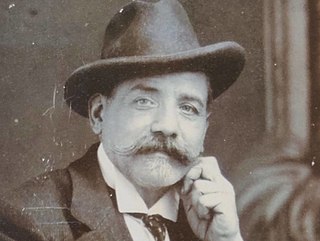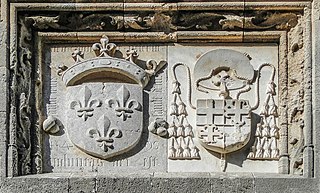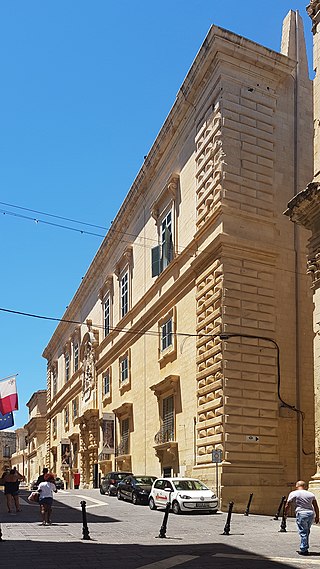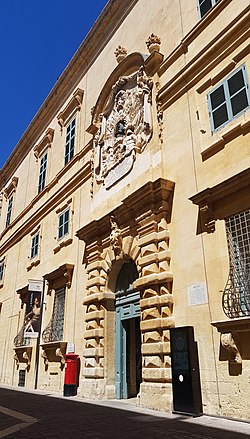
Valletta is the capital city of Malta and one of its 68 council areas. Located between the Grand Harbour to the east and Marsamxett Harbour to the west, its population as of 2021 was 5,157. As Malta’s capital city, it is a commercial centre for shopping, bars, dining, and café life. It is also the southernmost capital of Europe, and at just 0.61 square kilometres (0.24 sq mi), it is the European Union's smallest capital city.

Giuseppe Calì was a Maltese painter of Italian descent.

Antonio Sciortino was a Maltese artist, considered Malta's foremost sculptor of the twentieth century. His career unfolded almost entirely in Rome, where he resided from 1900 till 1936. Despite his stable residence in Rome, Sciortino maintained strong connections with Malta, where he was commissioned several public monuments, and where its bronzes where later acquired by the Fine Arts Museum.

The Auberge d'Aragon is an auberge in Valletta, Malta. It was built in 1571 to house knights of the Order of Saint John from the langue of Aragon, Navarre and Catalonia. It is the only surviving auberge in Valletta which retains its original Mannerist design by the architect Girolamo Cassar.

A langue or tongue was an administrative division of the Knights Hospitaller between 1319 and 1798. The term referred to a rough ethno-linguistic division of the geographical distribution of the Order's members and possessions. Each langue was subdivided into Priories or Grand Priories, Bailiwicks and Commanderies. Each langue had an auberge as its headquarters, some of which still survive in Rhodes, Birgu and Valletta.

Maltese architecture has its origins in prehistory, and some of the oldest free-standing structures on Earth – a series of megalithic temples – can be found on Malta. The islands were colonized by the Phoenicians and later the Romans, who established the cities of Melite and Gaulos. Although these were substantial settlements and are known to have had numerous temples, churches and palaces, few remains have survived apart from some architectural fragments.
This page list topics related to Malta.

The Auberge de Castille, historically in full known as the Auberge de Castille et Portugal, is an auberge in Valletta, Malta. The auberge is located at Castile Place, close to Saint James Cavalier, the Malta Stock Exchange, and the Upper Barrakka Gardens. It sits at the highest point of Valletta and overlooks Floriana and the Grand Harbour area.

The National Museum of Archaeology is a Maltese museum in Valletta, with artefacts from prehistory, Phoenician times and a notable numismatic collection. It is managed by Heritage Malta.

Auberge de Provence is an auberge in Valletta, Malta. It was built in the sixteenth century to house knights of the Order of Saint John from the langue of Provence. It now houses the National Museum of Archaeology.

The Auberge de Bavière is a palace in Valletta, Malta. It was built as Palazzo Carneiro in 1696, and was the residence of Grand Master Marc'Antonio Zondadari in the early 18th century. In 1784, it was converted into the auberge for the Anglo-Bavarian langue of the Order of Saint John, and remained so until the French occupation of Malta in 1798.

The Auberge d'Italie is an auberge in Valletta, Malta. It was built in various stages in the late 16th century to house knights of the Order of Saint John from the langue of Italy, and it originally had a Mannerist design by Girolamo Cassar and several other architects. The building continued to be modified throughout the course of the 17th century, with the last major renovation being carried out in the 1680s during the magistracy of Gregorio Carafa, giving the building a Baroque character.

The Auberge d'Italie was an auberge in Birgu, Malta. It was built in the sixteenth century to house knights of the Order of Saint John from the langue of Italy.

Palazzo Parisio, sometimes known as Casa Parisio, is a palace in Valletta, Malta. It was built in the 1740s by Domenico Sceberras, and eventually passed into the hands of the Muscati and Parisio Muscati families. It was Napoleon's residence for six days in June 1798, during the early days of the French occupation of Malta. The palace was eventually acquired by the de Piro family, and was later purchased by the Government of Malta. It was used as the General Post Office from 1886 to 1973, then the Ministry for Agriculture, and it now houses the Ministry for Foreign Affairs.

Abstract painting is a 1998 abstract oil painting by Victor Pasmore.

The Malta Postal Museum is a postal museum in Valletta, Malta. It is run by the postal operator MaltaPost, and it was inaugurated on 17 June 2016. The museum is housed in a restored 20th-century townhouse in the centre of Valletta, close to the Grandmaster's Palace and the Church of Our Lady of Damascus.

Admiralty House, formerly known as Casa Miari, Palazzo Don Raimondo and by several other names, is a palace in Valletta, Malta. It was originally built in 1569–70 as two private houses by Fra Jean de Soubiran dit Arafat, a knight of the Order of St. John. The houses were later leased to various owners, including Fra Raimondo de Sousa y Silva, who rebuilt them a single residence between 1761 and 1763.
Andrea Belli was a Maltese architect and businessman. He designed several Baroque buildings, including Auberge de Castille in Valletta, which is now the Office of the Prime Minister of Malta.

Edward Caruana Dingli was a Maltese painter.

Les Gavroches is a bronze sculpture by Antonio Sciortino, depicting Parisian street children inspired by Gavroche from the 1862 Victor Hugo novel Les Misérables. The statue was cast in 1904, and for most of the 20th century it was displayed at the Upper Barrakka Gardens in Valletta, Malta. In 2000, the statue was restored and transferred to the National Museum of Fine Arts in the same city, and a replica was placed at the Upper Barrakka.
























